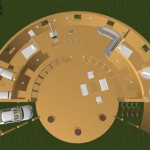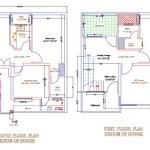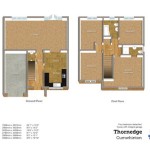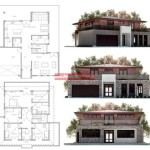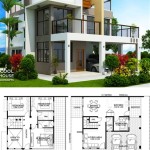Typical House Floor Plan Dimensions
When designing or building a house, it is crucial to consider the dimensions of each room to ensure a comfortable and functional living space. Typical house floor plan dimensions vary depending on factors such as the size of the house, the number of rooms, and the architectural style. However, there are some general guidelines that can help you achieve a well-balanced and proportional floor plan.
Living Room
The living room is typically the largest room in the house and serves as a central gathering space. The ideal dimensions for a living room are between 12' x 15' and 15' x 20'. This allows for ample seating, a coffee table, and additional furniture. For larger living rooms, consider dividing the space into distinct areas, such as a conversation area and a media area.
Kitchen
The kitchen is a highly functional space that requires careful planning. A typical kitchen floor plan includes a work triangle, which is the optimal arrangement of the sink, refrigerator, and stove. The dimensions of the kitchen will depend on the number of appliances and cabinets you want to include. A common kitchen size is 10' x 12', but larger kitchens can range up to 15' x 20'.
Bedrooms
The appropriate dimensions for a bedroom will depend on the size of the bed and any additional furniture you want to include, such as a dresser or desk. A master bedroom typically has dimensions of 12' x 14' or larger, while smaller bedrooms can be around 10' x 10'. It is important to ensure that there is enough space around the bed and other furniture to move around comfortably.
Bathrooms
Bathrooms should be designed to provide privacy and functionality. A typical full bathroom includes a toilet, sink, and shower or bathtub. The dimensions of a full bathroom can range from 5' x 8' to 8' x 10'. Half bathrooms, which only include a toilet and sink, are typically smaller, around 3' x 5'.
Hallways and Entryways
Hallways and entryways serve as transitions between rooms and should be designed to flow seamlessly. The recommended width for hallways is 3' to 4', while entryways can be slightly wider, around 4' to 6'. This allows for easy movement and accommodates furniture or art pieces.
Exterior Dimensions
In addition to the interior dimensions, the exterior dimensions of the house should also be considered. The overall size of the house will depend on the number of rooms and the size of the property. A typical ranch-style house has dimensions of around 50' x 30', while a two-story house can be around 30' x 40'.
Conclusion
Typical house floor plan dimensions serve as a guide to help you create a well-proportioned and functional home. By adhering to these general guidelines, you can ensure that each room is comfortable, inviting, and meets your specific needs. Remember to adjust the dimensions as necessary to accommodate your personal preferences and the unique characteristics of your property.

A Floorplan Of Single Family House All Dimensions In Meters Scientific Diagram

12 Examples Of Floor Plans With Dimensions

12 Examples Of Floor Plans With Dimensions

Floor Plans With Dimensions Including Examples Cedreo

How To Read Floor Plans With Dimensions A Guide

House Plans How To Design Your Home Plan

How To Read Floor Plans With Dimensions A Guide

How To Read A Floor Plan With Dimensions Houseplans Blog Com

How To Read A Floor Plan With Dimensions Houseplans Blog Com

12 Examples Of Floor Plans With Dimensions

